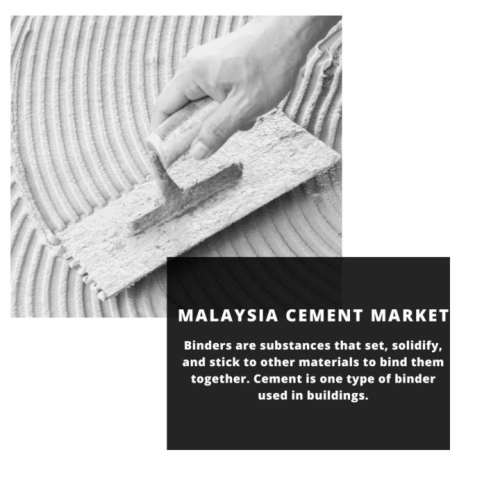
- Get in Touch with Us

Last Updated: Apr 25, 2025 | Study Period: 2022-2030
Binders are substances that set, solidify, and stick to other materials to bind them together. Cement is one type of binder used in buildings.
Geopolymer cement and portland cement are the two primary types of cement. The majority of the time, cement is used to bind aggregate, which is made up of sand and gravel.
Mortar for masonry is made when fine aggregate (sand) is mixed in, and concrete is made when sand and gravel are combined. Due to water being the planet's most consumed resource, it is the material that is utilised the most frequently overall.

When used in construction, cement can be either hydraulic or non-hydraulic, depending on the cement's ability to set in the presence of water. Inorganic cement is occasionally used; it is typically lime- or calcium-silicate-based.
The Malaysia Cement market accounted for $XX Billion in 2021 and is anticipated to reach $XX Billion by 2030, registering a CAGR of XX% from 2022 to 2030.
In a cash and stock deal for RM5.16 billion, YTL Cement Bhd, a division of YTL Corp Bhd, agreed to transfer all of its cement and ready-mixed concrete operations in Malaysia to Malayan Cement Bhd, which is a 76.98%-owned subsidiary.
A new cement plant with a 5000 tpd capacity will be built by KHD under a â¬100 million contract from Straits Cement. The new facility, which will be built close to Kuantan, Malaysia, will be constructed in accordance with the most recent environmental regulations.
A contract between LafargeHolcim and YTL Cement Berhad for the sale of Lafarge Malaysia Berhad's complete 51 percent ownership was signed.
The purchase price of USD 396 million, or MYR 3.75 per share, is fully payable in cash. Compared to Lafarge Malaysia Berhad's last 90 days of trading on the Malaysian stock exchange, this price is 43 percent more expensive.
| Sl no | Topic |
| 1 | Market Segmentation |
| 2 | Scope of the report |
| 3 | Abbreviations |
| 4 | Research Methodology |
| 5 | Executive Summary |
| 6 | Introduction |
| 7 | Insights from Industry stakeholders |
| 8 | Cost breakdown of Product by sub-components and average profit margin |
| 9 | Disruptive innovation in the Industry |
| 10 | Technology trends in the Industry |
| 11 | Consumer trends in the industry |
| 12 | Recent Production Milestones |
| 13 | Component Manufacturing in US, EU and China |
| 14 | COVID-19 impact on overall market |
| 15 | COVID-19 impact on Production of components |
| 16 | COVID-19 impact on Point of sale |
| 17 | Market Segmentation, Dynamics and Forecast by Geography, 2022-2030 |
| 18 | Market Segmentation, Dynamics and Forecast by Product Type, 2022-2030 |
| 19 | Market Segmentation, Dynamics and Forecast by Application, 2022-2030 |
| 20 | Market Segmentation, Dynamics and Forecast by End use, 2022-2030 |
| 21 | Product installation rate by OEM, 2022 |
| 22 | Incline/Decline in Average B-2-B selling price in past 5 years |
| 23 | Competition from substitute products |
| 24 | Gross margin and average profitability of suppliers |
| 25 | New product development in past 12 months |
| 26 | M&A in past 12 months |
| 27 | Growth strategy of leading players |
| 28 | Market share of vendors, 2022 |
| 29 | Company Profiles |
| 30 | Unmet needs and opportunity for new suppliers |
| 31 | Conclusion |
| 32 | Appendix |